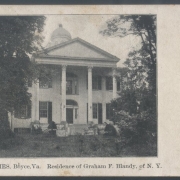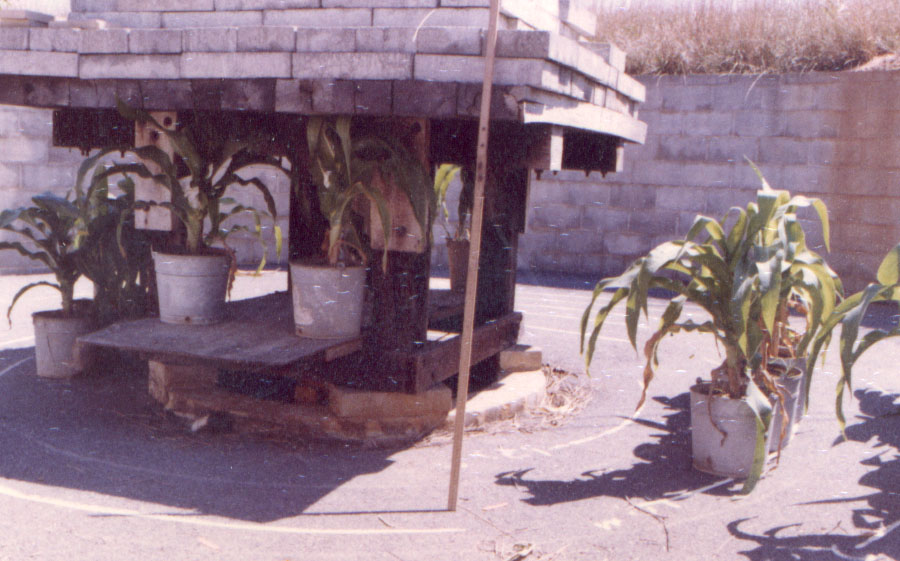The Antebellum History of the Tuleyries
The 712-acres of land that is now Blandy Experimental Farm was once part of the Tuleyries estate. In the 1780s, Joseph Tuley Sr. arrived in what was then Frederick County (now Clarke), Virginia. He owned a successful tannery based in the nearby town of Millwood, VA and purchased 420 acres of land from Alexander Henderson in 1806. After Joseph Sr.’s death in 1825, his son, Joseph Tuley Jr., inherited that land along with other acquisitions and commissioned the construction of the Tuleyries mansion in the 1830s.
Both father and son enslaved Africans to work in the tannery, fields, orchards, and their homes. The 1840 census tallied 73 people under Tuley enslavement, one of the largest holdings in the area. Joseph Tuley Jr. died in June 1860, just a couple months after the start of the American Civil War. In the aftermath of her husband’s death and facing the uncertainty of debt and the Civil War, the widow Mary Tuley sold her dower rights to her son, Joseph Tuley Mitchell. An advertisement in the Staunton Spectator and General Advertiser announced an estate sale that included 63 enslaved people.
The labor of those enslaved by the Tuley family has left an enduring mark on Blandy’s 712 acres. They likely built the stone walls that still divide many of the fields on the landscape. The most visible legacy of the history of enslavement is the east wing of the Quarters building (the center and west wings were added by the University of Virginia in 1941). This brick structure served as a barracks for many of those enslaved at the Tuleyries from the 1830s until emancipation. A cemetery for enslaved people also resides on the property. Ground-penetrating radar revealed the presence of 40 unmarked graves. The time spanned by the burials is currently unknown.
We know little about the lives of the people who were enslaved at the Tuleyries as yet, and we know nothing about the identity of those who were buried there. We have begun researching this chapter of the history of the property, however. In 2021, Antonio Austin, a history Ph.D. student at Howard University, spent a summer as an intern at Blandy and curated a great deal of information collected from the Clarke County Historical Association, the Clarke and Frederick County Courthouses, from Clarke County historian Maral Kalbian, and from other sources. His findings include the names (usually only a first name, but occasionally a family name), relationships, and even some stories. For example, a newspaper advertisement commissioned by Joseph Tuley Jr. offered a reward for the capture and return of a 17-year-old woman named Susanna who had emancipated herself from bondage at the Tuleyries.
Our research on the enslaved people of the Tuleyries will continue in years to come. We encourage anyone with knowledge of or connections to this history to contact us at blandy@virginia.edu.

The Formation of Blandy and Orland E. White: 1926-1955
Blandy Experimental Farm came into being in 1926 when Graham Blandy willed 700 acres of his land, part of the historic 'Tuleyries' estate, to the University of Virginia. His will stipulated that it should be called "Blandy Experimental Farm" and used to train college students in farming methods. In 1927, Orland E. White was appointed the first director of the farm and in addition to using it as a field research station and training ground for agricultural techniques, he began to turn it into an arboretum as well, planting a wide variety of trees around the property. Dr. White took a particular interest in planting trees not thought to be hardy in Virginia, including several Arizona cypress trees that are still alive at Blandy today. The ginkgo grove was also planted during this time, as part of an experiment to see how common each sex of ginkgo trees were in comparison to each other.

The Quarters at Blandy Graham Blandy
Radiation Experiments and the Slow Years: 1955-1982
In the late 1950s, Blandy received a federal grant to install a radiation pit and test the effects of radiation on plants. Under the direction of Dr. Ralph Singleton several radiation experiments were carried out, primarily on corn plants, in an attempt to cause mutations that might improve the crops in some way. The radiation pit has long since been dismantled and removed. Also during this time the American Boxwood Society was founded and headquartered at Blandy. By the mid 1960s however, most biological research was being done in a lab and UVA lost much interest in Blandy as a field station. Blandy fell into a low budget holding pattern until the early 1980s.

Corn near the radiation pit
Opening to the Public and the State Arboretum of Virginia: 1982 - Present
Until Dr. Ed Conner was appointed director of Blandy in 1982, the property had been closed off to the public, only accessible to the university students, staff, and faculty who worked there. Dr. Conner decided to turn the now well-established arboretum into a public garden, and began organizing significant fundraising and volunteer efforts to turn this dream into a reality. In 1984, the "Friends of Blandy" was formed to raise money for the arboretum (now known as the Foundation of the State Arboretum). By 1986, the Virginia general assembly designated the property as the State Arboretum of Virginia, and soon a number of popular public events became tradition, including the annual mother's day 'Garden Fair' plant sale and winter holiday workshops, both of which continue until the present day. In the 90s, many of the herbaceous gardens at Blandy were formed, including the herb garden and the native plant trail.
Research was still a priority during this time, and a summer research program for undergraduates was formed, as well as a seminar series and a visiting researcher program. Many research projects today at Blandy focus on the ecological relationships of plants and animals, as well as the effects of human influence on natural ecosystems.
